<–TODO: This page should be updated. There are at least, 3 points to improve, more likely some more: 1. Compare instructions to add decal with actual process in the program. 2. There is another decal type, “spherical”, that’s not mentioned in the text. 3. Clicking on “Properties” doesn’t open a dialog but returns an error message. –>
印花
印花是直接在物件上贴图的方法,这种贴图方法不需要依靠材质,可以在物件的局部贴图。使用印花可以修改物件局部的颜色、反射或凹凸。 一个印花只能使用一张图片,而且该图片不像材质里的图片可以重复拼贴。 印花的使用方法:
墙上的图案。 物件上的标签或商标。 模型上的标志。 彩绘玻璃。
 附注: 只有在启用 OpenGL 且显示模式为线框模式时才能预览印花。 选项 > 视图 > 显示模式 > 线框模式 > 其他设置 > 使用显示管线中的显示管线 必须设置为 OpenGL。
附注: 只有在启用 OpenGL 且显示模式为线框模式时才能预览印花。 选项 > 视图 > 显示模式 > 线框模式 > 其他设置 > 使用显示管线中的显示管线 必须设置为 OpenGL。
放置印花
加入
- 选取一个或以上的物件。
- 从编辑菜单选择物件属性。
- 在属性对话框切换到 Flamingo nXt 印花页面。
- 按新增按钮。
- 在打开位图对话框中,选择一张位图,并点击打开。
Note
Refresh the image definition
When a bitmap file is changed using an image editor such as Photoshop, you must refresh the bitmap definition in Flamingo nXt.
To refresh the bitmap
On the Flamingo nXt menu, click Utilities > Clear bitmap cache.
编辑位置
- 按编辑位置按钮。
- 在选取控制点提示下, 移动印花贴图轴上的控制点可以改变印花的位置。
- 按 Enter 完成。
属性
- 按属性按钮。
- 印花属性对话框有許多印花的设置可以修改。
删除
点击删除按钮。
上移 / 下移
当一个物件上有数个印花重叠时,会需要设置印花显示的前后顺序,清单里最上面的印花在物件上会显示在最前面。
按上移或下移按钮可以将选取的印花在清单中上、下移动。
放置平面印花
- 依照提示指定印花的位置、宽度与高度方向。
- 在选取控制点… 提示下,移动控制点调整印花贴图的位置、大小与旋转角度。 或按 Enter 放置印花。
选项
移动
移动印花的位置,就像 Rhino 的 Move 指令一样指定移动的起点与移动的终点。
使用图片的宽高比
使用图片的宽高比例设置印花,避免贴图变形。
放置圆柱印花
- 依照提示指定圆柱的中心点位置。
- 在选取控制点… 提示下,移动控制点调整印花贴图的位置、大小与旋转角度。 或按 Enter 放置印花。
设置或编辑印花的位置
附注:在有弧度的曲面上使用平面印花贴图时,必需将整个贴图轴置于曲面后方,因为贴图轴突出于曲面前方的部分无法将贴图投影至曲面上。
同时调整印花的宽度与高度
移动印花贴图轴的角控制点。
调整印花的高度
移动印花贴图轴上、下边的控制点。
调整印花的宽度
移动印花贴图轴左、右边的控制点。
移动印花
移动印花贴图轴中心的控制点。
旋转印花
移动印花贴图轴 X、Y、Z 三个轴向箭头尖端的控制点。
印花属性
以印花贴图取代物件上某一部分材质的颜色是印花常用的方法。
投影方式
决定如何将印花贴图投影至物件上,在放置印花贴图轴时可以事先创建一些建构线辅助,再配合物件锁点精确放置印花贴图。
圆柱体
圆柱体印花贴图轴适用于在瓶罐类似的物件上贴上标签。
圆柱体印花贴图轴的一个方向是直的,另一个方向环绕物件。
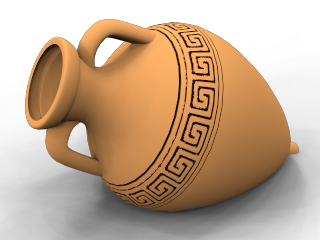
平面
平面印花贴图轴是最常用的方式,适用于在平面或是弧度不大的曲面上贴上图案。
平面印花贴图轴的宽度与高度可以任意改变,但它的宽度与高度的比例与使用的图片不一致时,图片会延展或挤压变形。
在有弧度的曲面上使用平面印花贴图时,必需将整个贴图轴置于曲面后方,因为贴图轴突出于曲面前方的部分无法将贴图投影至曲面上。

UV
UV 印花贴图轴适用于类似头发或树干这种沿曲面延伸的贴图。
它会将贴图布满整个曲面,无法控制贴图位置。
UV 印花贴图是以曲面 U、V 两个方向的参数坐标做贴图的对应,这种方式的贴图可能会有在曲面上的一部分挤压变形,但在另一部分的延展变形不平均的情形。

浏览
变更图片文件。
Note
Refresh the image definition
When a bitmap file is changed using an image editor such as Photoshop, you must refresh the bitmap definition in Flamingo nXt.
To refresh the bitmap
On the Flamingo nXt menu, click Utilities > Clear bitmap cache.
强度
颜色
调整印花贴图的透明度,可以让物件材质的颜色透出印花。请参考材质贴图属性 > 颜色强度。
凹凸
以印花贴图像素的灰阶值在物件上产生视觉上的凹凸效果。请参考:材质贴图属性 > 凹凸强度。
反射度
控制印花贴图的反射度,可以用来让印花与物件本身的材质有所区别,例如塑料瓶上的铝箔标签,默认值是完全没有反射。
强度
调整反光的强度,加大这个数值会加大反光的大小与亮度。请参考:高级材质属性 > 强度。
锐利度
设置物件表面的反光大小,数字越小,反光越大、越模糊。数值越大,反光越小、越锐利。請參考:高级材质属性 > 锐利度。
金属
将材质的反光颜色设置为与材质颜色相同。请参考:高级材质属性 > 金属。
Linking options
Specifies how the image file will be linked to materials.
Linked
Creates a link to the image file. The file must be present on the local disk.
Embedded
Embeds the image information in the current file.
Linked and embedded
If the bitmap is found on the disk before rendering, the external file is used. If the image cannot be found on the disk, the internal definition will be used.
Note: To see changes in linked or linked and embedded files go to the Flamingo nXt menu, click Utilities and then click Clear bitmap cache.
Masking
Obscures portions of the image based on either a color value or an alpha channel stored in the image. This allows textures to have complex shaped boundaries and create complex effects such as holes in a surface.
In this example, an image with an alpha-channel background is placed as a decal on a rectangular surface. Masking for materials works the same..

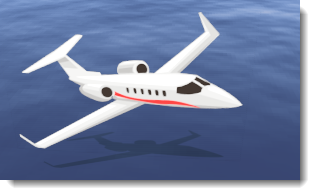 Original decal image. The gray checkered area represents the image alpha channel.
Original decal image. The gray checkered area represents the image alpha channel.
Masking information can come from three sources in the bitmap:
None
With no masking, the image obscures the underlying material. Masking allows the material to show through the image where the alpha channel or masking color exists. The material assigned to a planar surface in this example has a red base color
 Without masking (left) the image covers the surface, with masking (right), the red material shows through.
Without masking (left) the image covers the surface, with masking (right), the red material shows through.
Alpha Channel
Uses the image’s alpha channel to define the masked area if one exists.

 Original on the left. The gray checkered area represents the image alpha channel. On the right is the image over a water surface.
Original on the left. The gray checkered area represents the image alpha channel. On the right is the image over a water surface.
The alpha channel is a portion of each pixel’s data that is reserved for transparency information. Alpha channels create and store masks that let you isolate and protect parts of an image while you apply color changes, filters, or other effects to the rest of the image. Each pixel in an image is described as channels of data that define the mixture of the red, green, and blue (RGB) colors. The alpha channel is an 8-bit (256-level) grayscale representation of the image that masks the color of the underlying pixel. The value of the alpha mask determines the intensity of the pixel color. If the Alpha channel is 100%, the images pixel will be complete transparent. At other alpha strengths. the image pixels will blended with transparency.
Color
If alpha channel does not exist in an image, a color in the image can be specified as a mask. There is also a sensitivity number to make the mask more or less sensitivity to a single specific color as a masked color. Selecting the Color option will activate the Color Dropper, Color Selector and Sensitivity controls.
Color Dropper
Click to select the mask color from the bitmap. Click on the Color Dropper, then on the bitmap to pick the color. This control is only available when the Color option is selected.
Color
Use the Color Selector to set the main color. See the Color Selector  topic for details.
topic for details.
Sensitivity
The value indicates the size of the area around the color that is also masked. Must be greater than 0.0 for color masking to occur. This control is only available when the Color option is selected.
Blur
Partially masks pixels. The value determines the magnitude of partial masking around the masked color. This control is only available when the Color option is selected.
Reverse
Inverts the mask—pixels that would have been masked are now included, and vice versa.

Transparent
Makes the masked area of the underlying object transparent so other objects or the background behind the object can be seen through the object. Normally, the material of the object shows through in that area. Transparent masking allows a more natural shadow and allows the background objects to show. The underlying material could simply be transparent, but sometimes it is useful to make the surface behind the decal transparent while keeping other areas of the surface opaque.


Show masked colors
Graphically displays the effects of masking as the parameters change. Use the Color Selector  provided to select the display color of the masked pixels. Changing this color or the setting of the checkbox does not change the masked color. This is simply a graphical tool for editing the mask.
provided to select the display color of the masked pixels. Changing this color or the setting of the checkbox does not change the masked color. This is simply a graphical tool for editing the mask.

高级
双面
让印花贴图同时出现在曲面的正面与背面。
镜像
镜像印花贴图。
投影方向
向后
从印花贴图轴的背面投影至物件上。
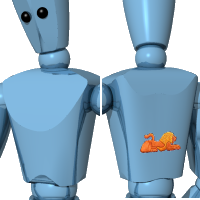 前 (左)、后 (右)。
前 (左)、后 (右)。
向前
从印花贴图轴的正面投影至物件上。
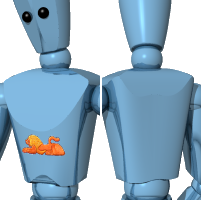 前 (左)、后 (右)。
前 (左)、后 (右)。
双向
从印花贴图轴的正面与背面投影至物件上。
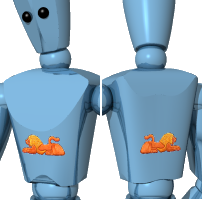 前 (左)、后 (右)。
前 (左)、后 (右)。